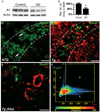DnaJA1 antagonizes constitutive Hsp70-mediated stabilization of tau
- PMID: 22343013
- PMCID: PMC3371317
- DOI: 10.1016/j.jmb.2012.02.003
DnaJA1 antagonizes constitutive Hsp70-mediated stabilization of tau
Abstract
Tau aggregation and amyloidogenesis are common hallmarks for neurodegenerative disorders called tauopathies. The molecular chaperone network constitutes the cellular defense against insults such as tau aggregation. However, chaperone effects on tau are dichotomous. Loss of tau's microtubule-binding activity facilitates an inappropriate chaperone interaction that promotes an amyloidogenic tau conformation. Conversely, other chaperones are capable of promoting tau clearance. Here, we demonstrate that a critical contributor to tau triage is the DnaJ-binding domain of Hsp70 proteins. In particular, over-expression of the constitutive DnaJ, DnaJA1, mediated tau clearance, while knockdown facilitated tau accumulation. This clearance was not specific to distinct pathogenic tau species. The activity of DnaJA1 was attenuated by concomitant increases in Hsp70. Tau reductions facilitated by DnaJA1 were dependent on the integrity of lysines known to be poly-ubiquitinated in human Alzheimer's brain. In vivo, DnaJA1 and tau levels were inversely correlated. The effects of DnaJA1 were partially specific: DnaJA1 reduced the levels of a polyQ protein but had no significant effect on α-synuclein levels. These data suggest that DnaJA1 triages all tau species for ubiquitin-dependent clearance mechanisms. Moreover, the levels of DnaJA1 and Hsp70 seem to play against each other with regard to tau: as DnaJA1 levels increase, tau levels are reduced, but this can be prevented if Hsp70 levels are simultaneously induced. Thus, the DnaJ repertoire possibly represents a powerful set of genetic modifiers for tau pathogenesis. Further investigations could provide new insights about triage decisions that facilitate or prevent amyloidogenesis of tau and other proteins associated with neurodegenerative disease.
Copyright © 2012 Elsevier Ltd. All rights reserved.
Figures






Similar articles
-
Cereblon Regulates the Proteotoxicity of Tau by Tuning the Chaperone Activity of DNAJA1.J Neurosci. 2021 Jun 16;41(24):5138-5156. doi: 10.1523/JNEUROSCI.2494-20.2021. Epub 2021 May 10. J Neurosci. 2021. PMID: 33972400 Free PMC article.
-
Disassembly of Tau fibrils by the human Hsp70 disaggregation machinery generates small seeding-competent species.J Biol Chem. 2020 Jul 10;295(28):9676-9690. doi: 10.1074/jbc.RA120.013478. Epub 2020 May 28. J Biol Chem. 2020. PMID: 32467226 Free PMC article.
-
Hsp40s play complementary roles in the prevention of tau amyloid formation.Elife. 2021 Aug 9;10:e69601. doi: 10.7554/eLife.69601. Elife. 2021. PMID: 34369377 Free PMC article.
-
The diversity of the DnaJ/Hsp40 family, the crucial partners for Hsp70 chaperones.Cell Mol Life Sci. 2006 Nov;63(22):2560-70. doi: 10.1007/s00018-006-6192-6. Cell Mol Life Sci. 2006. PMID: 16952052 Free PMC article. Review.
-
Novel insights into the post-translational modifications of Ydj1/DNAJA1 co-chaperones.Cell Stress Chaperones. 2024 Feb;29(1):1-9. doi: 10.1016/j.cstres.2023.11.001. Epub 2023 Nov 17. Cell Stress Chaperones. 2024. PMID: 38309209 Free PMC article. Review.
Cited by
-
Therapeutic Strategies for Restoring Tau Homeostasis.Cold Spring Harb Perspect Med. 2018 Jan 2;8(1):a024612. doi: 10.1101/cshperspect.a024612. Cold Spring Harb Perspect Med. 2018. PMID: 28159830 Free PMC article. Review.
-
Tau Protein Interaction Partners and Their Roles in Alzheimer's Disease and Other Tauopathies.Int J Mol Sci. 2021 Aug 26;22(17):9207. doi: 10.3390/ijms22179207. Int J Mol Sci. 2021. PMID: 34502116 Free PMC article. Review.
-
Allosteric heat shock protein 70 inhibitors rapidly rescue synaptic plasticity deficits by reducing aberrant tau.Biol Psychiatry. 2013 Sep 1;74(5):367-74. doi: 10.1016/j.biopsych.2013.02.027. Epub 2013 Apr 19. Biol Psychiatry. 2013. PMID: 23607970 Free PMC article.
-
DnaJ/Hsc70 chaperone complexes control the extracellular release of neurodegenerative-associated proteins.EMBO J. 2016 Jul 15;35(14):1537-49. doi: 10.15252/embj.201593489. Epub 2016 Jun 3. EMBO J. 2016. PMID: 27261198 Free PMC article.
-
The HSP40 family chaperone isoform DNAJB6b prevents neuronal cells from tau aggregation.BMC Biol. 2023 Dec 18;21(1):293. doi: 10.1186/s12915-023-01798-6. BMC Biol. 2023. PMID: 38110916 Free PMC article.
References
-
- Hatahet F, Ruddock LW. Modulating proteostasis: peptidomimetic inhibitors and activators of protein folding. Curr Pharm Des. 2009;15:2488–2507. - PubMed
-
- Hardy J, Pittman A, Myers A, Fung HC, de Silva R, Duckworth J. Tangle diseases and the tau haplotypes. Alzheimer Dis Assoc Disord. 2006;20:60–62. - PubMed
-
- Bukau B, Horwich AL. The Hsp70 and Hsp60 chaperone machines. Cell. 1998;92:351–366. - PubMed
-
- Walter S, Buchner J. Molecular chaperones--cellular machines for protein folding. Angew Chem Int Ed Engl. 2002;41:1098–1113. - PubMed
-
- Takayama S, Xie Z, Reed JC. An evolutionarily conserved family of Hsp70/Hsc70 molecular chaperone regulators. J Biol Chem. 1999;274:781–786. - PubMed
Publication types
MeSH terms
Substances
Grants and funding
LinkOut - more resources
Full Text Sources
Other Literature Sources

